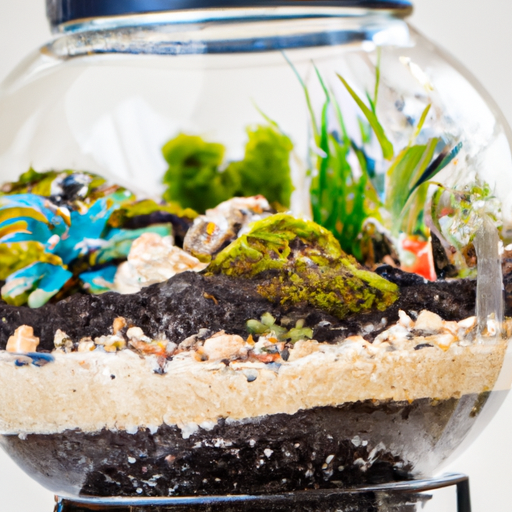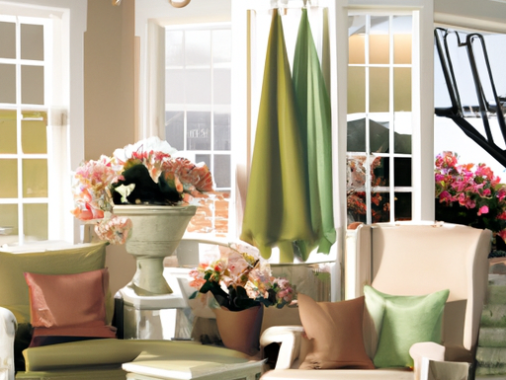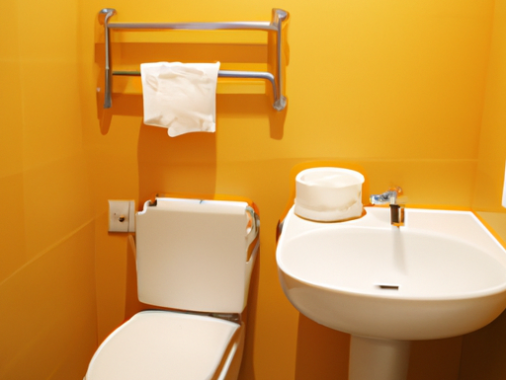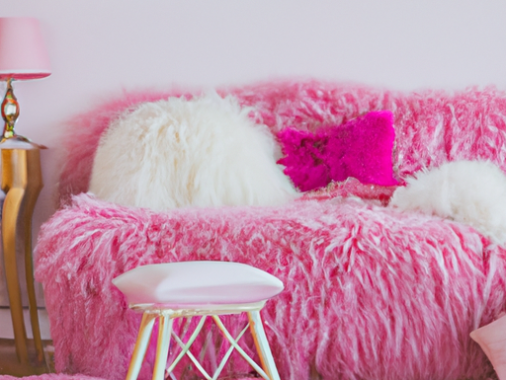-
Table of Contents
- Introduction
- How to Create a Low-Maintenance Terrarium
- 10 Creative Terrarium Ideas for Your Home
- The Benefits of Growing Plants in a Terrarium
- Tips for Choosing the Right Plants for Your Terrarium
- How to Care for a Terrarium
- DIY Terrarium Projects for Kids
- How to Make a Hanging Terrarium
- Q&A
- Conclusion
Introduction
Terrariums are a great way to bring a bit of nature into your home. They are easy to make and can be customized to fit any style or space. Whether you’re looking for a low-maintenance way to add greenery to your home or a creative project to do with your kids, terrariums are a great option. With a few simple supplies and a bit of creativity, you can create a beautiful terrarium that will bring life and color to any room. Here are some ideas to get you started.
How to Create a Low-Maintenance Terrarium
Creating a low-maintenance terrarium is a great way to bring a bit of nature into your home. With a few simple steps, you can create a beautiful and easy-to-care-for terrarium that will last for years.
First, choose a container for your terrarium. A glass container with a lid is ideal, as it will help to maintain the humidity and temperature levels inside the terrarium. Make sure the container is large enough to accommodate the plants you plan to use.
Next, add a layer of gravel to the bottom of the container. This will help to provide drainage for the plants.
Then, add a layer of activated charcoal. This will help to keep the terrarium clean and free of odors.
After that, add a layer of potting soil. Make sure to use a soil that is specifically designed for terrariums.
Now it’s time to add your plants. Choose plants that are suited to the environment you are creating. Succulents and air plants are great choices for terrariums, as they require minimal care.
Finally, add some decorations to your terrarium. You can use rocks, moss, and other natural elements to create a unique and beautiful display.
Once your terrarium is complete, it’s important to keep it in a location that receives indirect sunlight. This will help to keep the temperature and humidity levels in the terrarium at the right levels.
With these simple steps, you can create a beautiful and low-maintenance terrarium that will bring a bit of nature into your home.
10 Creative Terrarium Ideas for Your Home
1. Succulent Terrarium: Create a unique and eye-catching terrarium with a variety of succulents. This type of terrarium is easy to maintain and can be a great addition to any home.
2. Aquatic Terrarium: Create a beautiful aquatic terrarium with a variety of fish and aquatic plants. This type of terrarium is perfect for those who want to bring a bit of the outdoors into their home.
3. Desert Terrarium: Create a desert terrarium with a variety of cacti and succulents. This type of terrarium is perfect for those who want to bring a bit of the desert into their home.
4. Rainforest Terrarium: Create a rainforest terrarium with a variety of tropical plants and animals. This type of terrarium is perfect for those who want to bring a bit of the rainforest into their home.
5. Fairy Garden Terrarium: Create a magical fairy garden terrarium with a variety of miniature plants and accessories. This type of terrarium is perfect for those who want to bring a bit of fantasy into their home.
6. Zen Garden Terrarium: Create a tranquil zen garden terrarium with a variety of plants and stones. This type of terrarium is perfect for those who want to bring a bit of peace and tranquility into their home.
7. Moss Terrarium: Create a lush moss terrarium with a variety of mosses and other plants. This type of terrarium is perfect for those who want to bring a bit of nature into their home.
8. Terrarium Wall: Create a unique terrarium wall with a variety of plants and accessories. This type of terrarium is perfect for those who want to bring a bit of nature into their home in a unique way.
9. Living Picture Terrarium: Create a living picture terrarium with a variety of plants and accessories. This type of terrarium is perfect for those who want to bring a bit of art into their home.
10. Terrarium Table: Create a terrarium table with a variety of plants and accessories. This type of terrarium is perfect for those who want to bring a bit of nature into their home in a unique and stylish way.
The Benefits of Growing Plants in a Terrarium
Growing plants in a terrarium offers a number of benefits. A terrarium is a self-contained environment, which means that it is easy to maintain and requires minimal effort. The enclosed environment of a terrarium helps to maintain the ideal temperature and humidity levels for the plants, which helps them to thrive. Additionally, the terrarium acts as a natural filter, trapping dust and other particles that can damage the plants.
The terrarium also helps to conserve water, as the enclosed environment helps to reduce evaporation. This means that the plants will require less frequent watering, making it easier to maintain them. Furthermore, the terrarium can help to reduce the amount of fertilizer needed, as the enclosed environment helps to retain the nutrients in the soil.
The terrarium also provides a great way to display plants in a small space. The enclosed environment helps to create a miniature ecosystem, which can be a great conversation piece. Additionally, the terrarium can be used to create a unique and attractive display in any room.
Finally, growing plants in a terrarium can be a great way to teach children about the importance of caring for plants. The enclosed environment of the terrarium makes it easier for children to observe the plants and learn about their needs. This can help to foster a love of nature and an appreciation for the environment.
In conclusion, growing plants in a terrarium offers a number of benefits. The enclosed environment helps to maintain the ideal temperature and humidity levels for the plants, while also conserving water and reducing the amount of fertilizer needed. Additionally, the terrarium can be used to create a unique and attractive display in any room, and it can be a great way to teach children about the importance of caring for plants.
Tips for Choosing the Right Plants for Your Terrarium
1. Choose plants that are compatible with the environment of your terrarium. Consider the amount of light, humidity, and temperature that your terrarium will provide. Some plants require more light than others, while some prefer higher humidity levels.
2. Select plants that are easy to care for. Look for plants that are low-maintenance and require minimal pruning and fertilizing.
3. Consider the size of your terrarium. Choose plants that will fit comfortably in the space you have available.
4. Choose plants that will complement each other. Consider the colors, textures, and shapes of the plants you select.
5. Research the plants you are considering. Make sure you understand the care requirements for each plant before you purchase it.
6. Consider the type of terrarium you have. Some plants may not be suitable for open terrariums, while others may not thrive in closed terrariums.
7. Purchase healthy plants. Look for plants with vibrant colors and no signs of disease or pests.
8. Consider the type of soil you will use. Different plants require different types of soil, so make sure you select the right type for your plants.
9. Make sure you have the right tools and supplies. You will need a variety of tools and supplies to properly care for your plants, such as a watering can, fertilizer, and pruning shears.
10. Have fun! Creating a terrarium is a great way to express your creativity and bring a bit of nature into your home. Enjoy the process and have fun with it!
How to Care for a Terrarium
Terrariums are a great way to bring a bit of nature indoors. With the right care, they can be a beautiful addition to any home. Here are some tips for keeping your terrarium healthy and thriving.
1. Choose the right plants. When selecting plants for your terrarium, make sure to choose ones that are suited to the environment you are creating. Some plants require more light than others, so be sure to research the plants you are considering before making your purchase.
2. Provide adequate light. Most terrariums require some form of artificial light, such as a fluorescent bulb, to provide the plants with the light they need to grow. Place the light source close to the terrarium, but not too close, as this can cause the plants to become too hot.
3. Water your plants. Water your plants regularly, but be careful not to overwater them. Too much water can cause the plants to become waterlogged and can lead to root rot.
4. Prune your plants. Pruning your plants will help them to stay healthy and will also help to keep the terrarium looking neat and tidy.
5. Monitor the temperature. Make sure the temperature in your terrarium is not too hot or too cold. Most plants prefer temperatures between 65 and 75 degrees Fahrenheit.
By following these tips, you can ensure that your terrarium is a healthy and thriving environment for your plants. With the right care, your terrarium can be a beautiful addition to your home.
DIY Terrarium Projects for Kids
Terrariums are a great way to introduce children to the wonders of nature. Not only are they fun to make, but they also provide a great opportunity for kids to learn about plants and the environment. With a few simple supplies, you can create a beautiful terrarium that your kids will love. Here are some DIY terrarium projects for kids that are sure to be a hit.
1. Miniature Garden Terrarium: This project is perfect for kids who love to garden. Start by gathering a few small plants, such as succulents, and some soil. Place the plants in a glass container and fill it with soil. Add some rocks and moss for decoration and your miniature garden terrarium is complete.
2. Aquarium Terrarium: This project is perfect for kids who love animals. Start by gathering a few small fish, such as guppies, and some aquarium gravel. Place the fish in a glass container and fill it with gravel. Add some plants and decorations for a beautiful aquarium terrarium.
3. Fairy Garden Terrarium: This project is perfect for kids who love fairies. Start by gathering a few small plants, such as ferns, and some soil. Place the plants in a glass container and fill it with soil. Add some miniature furniture and decorations to create a magical fairy garden terrarium.
4. Desert Terrarium: This project is perfect for kids who love deserts. Start by gathering a few small cacti, such as prickly pear, and some sand. Place the cacti in a glass container and fill it with sand. Add some rocks and decorations to create a beautiful desert terrarium.
These are just a few of the many DIY terrarium projects for kids. With a little creativity and imagination, you can create a unique and beautiful terrarium that your kids will love.
How to Make a Hanging Terrarium
Creating a hanging terrarium is a great way to bring a bit of nature into your home. Not only are they beautiful to look at, but they are also easy to maintain. Here is a step-by-step guide to making your own hanging terrarium.
Step 1: Gather Your Supplies
You will need a glass container with a lid, potting soil, activated charcoal, small stones, and plants. Make sure the container is large enough to fit the plants you have chosen.
Step 2: Prepare the Container
Start by adding a layer of small stones to the bottom of the container. This will help with drainage. Next, add a layer of activated charcoal. This will help keep the soil fresh and free of bacteria.
Step 3: Add the Soil
Fill the container with potting soil, leaving enough room for the plants. Make sure the soil is evenly distributed.
Step 4: Plant the Plants
Carefully place the plants in the soil. Make sure to leave enough room between them so they have room to grow.
Step 5: Add the Lid
Place the lid on the container and secure it with a rubber band. This will help keep the moisture in and the pests out.
Step 6: Hang the Terrarium
Find a spot in your home that gets indirect sunlight and hang the terrarium. Make sure it is not in direct sunlight, as this can cause the plants to overheat.
Step 7: Water the Plants
Water the plants regularly, making sure not to over-water them. The soil should be damp, but not soggy.
Your hanging terrarium is now complete! With a little bit of care and attention, your terrarium will thrive and bring a bit of nature into your home.
Q&A
1. What materials do I need to make a terrarium?
You will need a glass container, potting soil, activated charcoal, small rocks, plants, and decorations.
2. What type of plants are best for a terrarium?
Terrariums are best suited for plants that thrive in humid, enclosed environments, such as ferns, mosses, and other low-light plants.
3. How often should I water my terrarium?
Terrariums should be watered every 1-2 weeks, depending on the type of plants you have.
4. How much light does a terrarium need?
Terrariums should be placed in an area that receives indirect sunlight.
5. How do I maintain a terrarium?
Maintaining a terrarium is relatively easy. You should check the soil moisture levels regularly and water as needed. You should also remove any dead or dying plants and prune any overgrown plants.
6. What type of decorations can I use in my terrarium?
You can use a variety of decorations in your terrarium, such as rocks, figurines, and other small items.
7. What are some creative terrarium ideas?
Some creative terrarium ideas include creating a desert terrarium, a rainforest terrarium, or a miniature garden terrarium. You can also create a terrarium with a theme, such as a beach or fairy garden.
Conclusion
Terrariums are a great way to bring a little bit of nature into your home. They are easy to make and can be customized to fit any space. With a little bit of creativity, you can create a unique and beautiful terrarium that will bring life and beauty to your home. Whether you choose to make a terrarium with succulents, cacti, or other plants, you can be sure that it will be a beautiful addition to your home.




